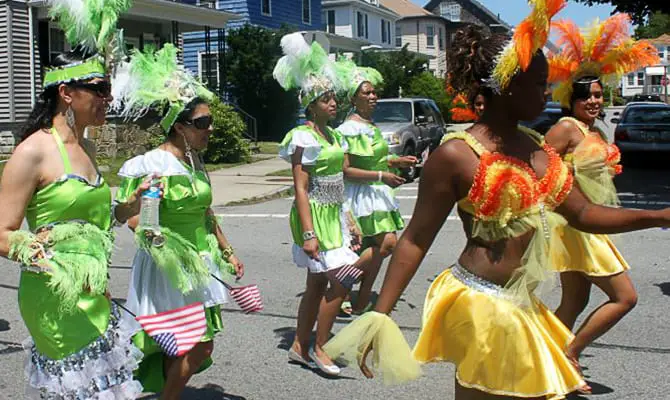Dancing is an important part of Cape Verdean culture. Cape Verdean dances blend African, Latin, and European influences, reflecting the diverse heritage of the West African island country.
Most Cape Verdean dances blend traditional styles with European or Latin influences like salsa and zouk.
Dancing is an integral part of the country’s cultural identity. Be it on the streets, in gatherings, or during festivals, dancing plays an important role in bringing Cape Verdeans together.
Here are the most popular Cape Verdean dances.
1. Funana
The Funana dance is a lively and spirited Cape Verdean dance featuring fast-paced rhythms and energetic movements performed in pairs or small groups. The dancers make quick steps, turns, and hip movements in sync with the music.
Funaná is deeply rooted in the culture of Cape Verde and has historically been associated with rural communities and agricultural work. The dance reflects the resilience and spirit of the Cape Verdeans, as it emerged as a form of expression and celebration despite the hardships faced by the islanders.
2. Coladeira
Coladeira is a popular dance style in Cape Verde characterized by smooth and rhythmic movements. It often accompanies coladeira music, which features guitar-based melodies and upbeat beats.
The dance often emphasizes a close connection between partners, with dancers maintaining eye contact and mirroring each other’s movements. Coladeira is romantic and joyful and is popular at weddings and other social gatherings whose themes are love and life.
3. Morna
The morna dance is a graceful and expressive dance style originating from Cape Verde. It is closely associated with the morna music genre, which is known for its melancholic melodies and heartfelt lyrics.
In the morna dance, dancers move with fluidity and elegance, expressing the emotions evoked by the music through their body movements. The dance often involves slow and deliberate steps, accompanied by subtle gestures and expressions.
4. Batuco
The batuco dance is a traditional dance style originating from Cape Verde, closely tied to the batuco music genre. It is characterized by its rhythmic movements, lively footwork, and call-and-response singing.
Batuco is deeply rooted in the history and culture of Cape Verde, with its origins tracing back to African dance traditions brought to the islands by slaves. The dance is typically performed in a circle or semicircle formation, with participants clapping their hands, stomping their feet, and moving in sync with the music.
5. Colá
The colá dance is a traditional Cape Verdean dance style closely associated with the coladeira music genre. It involves fluid hip movements, rhythmic footwork, and occasional turns or spins.
Colá dance is joyful and celebratory and is often performed at festivals and social gatherings to accompany the lively and infectious Cape Verdean music. Overall, the colá dance serves as an expression of the warmth, passion, and cultural richness of Cape Verde, inviting people to celebrate life and community through movement and music.
6. Talaia-baixo
The Talaia-baixo dance is a traditional Cape Verdean dance associated with the island of Santiago. It is a lively and rhythmic dance performed in a circular formation, with dancers moving in sync with the beat of the music. The participants often clap their hands, stomp their feet, and move their hips in a dynamic and energetic manner.
7. Contradança
The “contradança” is a dance of European roots, particularly Portugal. Due to the country’s colonial history, the dance is also quite popular in Cape Verde. The Cape Verdean version of the dance, however, has influences from African dances.
The contradança is typically performed in pairs, with dancers executing elegant and graceful movements in time with the music. It often involves intricate footwork, gentle turns, and gestures that convey a sense of romance.
8. Mazurka
Mazurka is also not native to Cape Verde; it was introduced by the Portuguese during the colonial period. The Cape Verdean mazurka has evolved to incorporate local influences, giving it a unique flavor distinct from its European origins.
In Cape Verde, the mazurka dance is often performed in pairs and features elegant and graceful movements. Dancers typically move in a circular or line formation, executing steps that reflect the rhythm and melody of the music.
Also Check: 25 Most Popular Traditional African Dances and Their Origins

